
|

|
Stimulator Configuration Note: This page documents the v2.1 configuration. Until July, 2006, all stimulators were of the version 1 or version 2 variety, with minor differences between them. You can distinguish them by:
In July, 2006, the version 2.1 stimulator has become available with a few key differences:
|
Feature |
Version 2.0 |
Version 2.1 |
| Tach Circuit | Two pot control using LM555 | Single pot control using AD654 and open collector switch. Includes tach on/off switch |
| LED's | F Idle, Injectors(2), Fuel Pump | same + 1 added LED for ignition |
| Power Input | 9V battery clip + terminal block | P5 wall wart jack + terminal block |
| O2 Simulator | 0-1V NB | Switchable 0-1V (NB) or 0-5V (WB) |
| Sensors | CLT, IAT, O2, TPM, RPM | same except for O2 enhancement |
| Board size | 3 in sq | 3 x 3.2 in |
| Spare pins | unused pins available on 0.1" spacing header |
The stimulator (aka. stim) is a small board that supplies the signals to MegaSquirt® controller that would normally come from the engine to your MegaSquirt® EFI Controller, and display the outputs from your MegaSquirt® controller on a series of LEDs. This allows you to test MegaSquirt® EFI Controller, and learn the tuning software. It also helps you to verify that MegaSquirt® is operating correctly if you have problems on the vehicle, and lets you 'play' with MegaSquirt® to better understand how it operates. Before assembling your MegaSquirt® EFI Controller, you should assemble the stimulator, which you will use to test your MegaSquirt® as you proceed
.Stimulator Parts Listing:
| R1, R2, R3, R6, R12 | 10kΩ sensor simulator pot, black body |
| R8, R10 | 100Ω, 1/4W resistor |
| R11 | 33kΩ, 1/4W resistor |
| R9 | 39kΩ, 1/4W resistor |
| R13, R14, R15, R16, R17 | 330Ω, 1/4W resistor |
| R7 | 1kΩ, 1/4W resistor |
| R4, R5 | 10kΩ, 1/4W resistor |
| C1 | 0.1 µF, cap |
| C2* | 0.22 µF, cap |
| Q1 | 2N3906 PNP transistor |
| U1 | AD654 Voltage to Frequency converter |
| P1 | female DB37 connector |
| P2 | 2-pin terminal block |
| S1, S2 | SPDT switch |
| D1, D2, D3, D4, D5 | T-1 3/4 LED, Red |
| J1 | 2.1 mm (P5) circular power jack |
| n/a | 300 ma, 12volt wall wart with p5 compatible plug |
* Note that the timing circuit is set up to provide a 0 to ~6500 rpm tach signal if your MegaSquirt® controller is configured for a V8. The maximum rpm can be easily adjusted by changing the value of C2. Using a 0.15 µF cap here will change the maximum rpm to around 4300 rpm while a 0.33 uF cap will increase it to about 10,000.
The V2.1 Stimulator Schematic
Many, many thanks to Jeff (enginesong on the forums) for producing these schematics and giving us permissions to display them here.
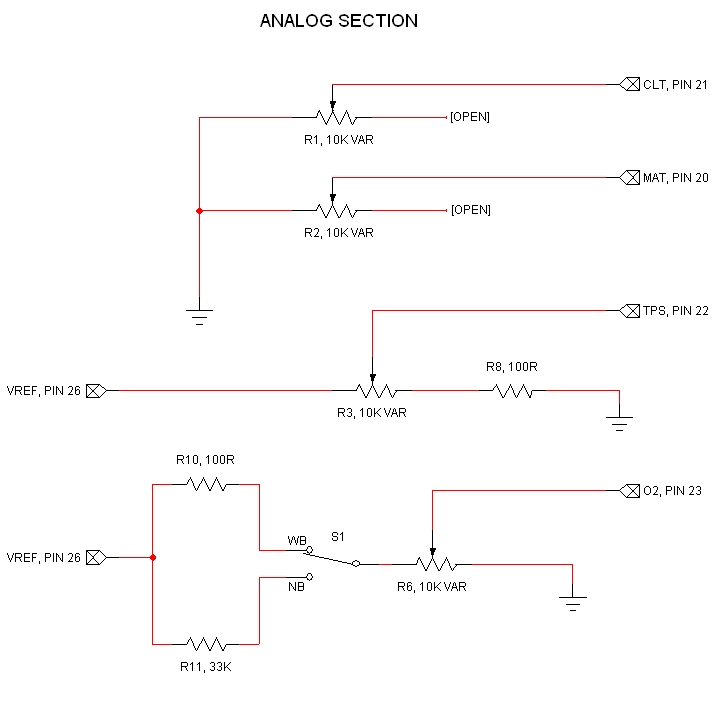
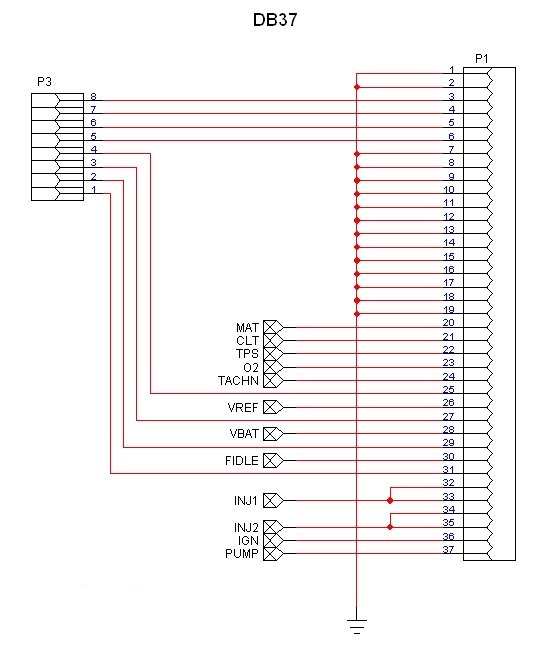
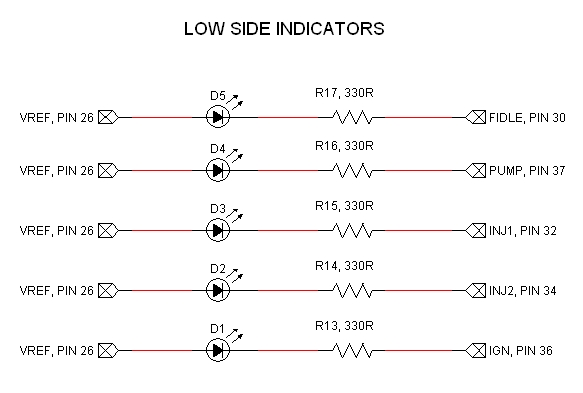
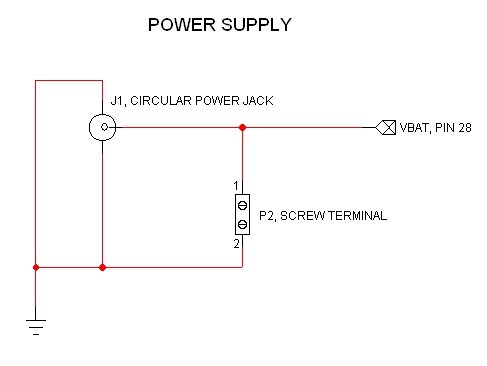
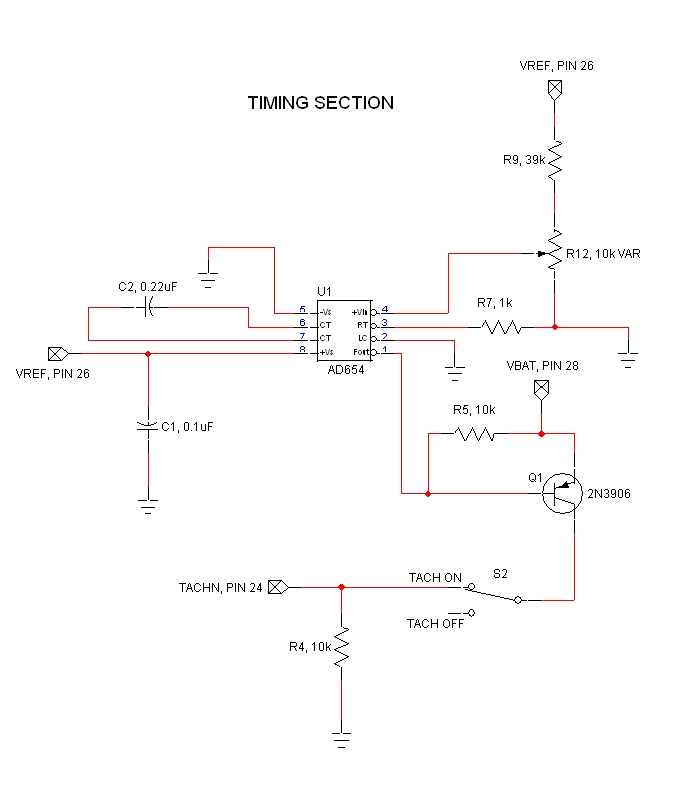
The installation process for the V2.1 stimulator is not critical. Parts can be installed in any convenient order, however, it is easiest to install the interior parts first, followed by the ones on the periphery. Start with the resistors and capacitors, followed by the AD654 and transistor. Be sure to verify that you have the 2N3906 transistor and the LED's in the correct orientation. The 3906 silk screen should make it clear which way it goes but the LED's are trickier. Install the LED's with the short leg and the flat side towards the outside edge of the board. Install the pots, switches, and DB37 last.
Capacitor Identification |
Capacitors may be marked directly with their capacitance. If not, they are frequently marked with numbers like: 104 K50 or 152 K100 The first two numbers are multiplied by ten to the power of the third number to getting the picofarad capacitance. For example, since 10 to the fourth power is 104 = 10 x 10 x 10 x 10 = 10,000, the first capacitor would be 10*10,000 = 100,000pF = 0.1µF, , since 1,000,000pF = 1µF, . The second capacitor would be 15 x 102 = 15 x 100 = 1500pF = .0015µF,. The upper case letter indicates the tolerance, M = 20%, K = 10%, J = 5%, H = 2.5% and F = ± 1pF. The last numbers are the rated voltage, 50 and 100 volts in these cases. |
Install and solder all the resistors in their respective locations as marked on the PCB. Note: be careful to space R9 above the PCB by 1/4 to 3/8 inch (7mm to 10mm). This resistor can get very hot (255°F, 124°C) in use, and spacing it up allows it to cool better and protects the PCB from excess heat. The other resistors don't get hot, and can be flush with the PCB. The resistor color band coding is as above, or you can use the chart below, and it is a good practice to verify each resistor's value with a multimeter before installing it.
| Resistor Band Color Reference |
|||||
| Color |
Band 1 |
Band 2 |
Multiplier |
Tolerance |
|
| Black | 0 | 0 | x 1 | not used | |
| Brown | 1 | 1 | x 10 | not used | |
| Red | 2 | 2 | x 100 | not used | |
| Orange | 3 | 3 | x 1000 = 1K | not used | |
| Yellow | 4 | 4 | x 10000 = 10K | not used | |
| Green | 5 | 5 | x 100000 = 100K | not used | |
| Blue | 6 | 6 | x 1000000 = 1M | not use | |
| Violet | 7 | 7 | not used | not used | |
| Gray | 8 | 8 | not used | not used | |
| White | 9 | 9 | not used | not used | |
| Gold | not used | not used | divide by 10 | ±5% | |
| Silver | not used | not used | divide by 100 | ±10% | |
| None | not used | not used | not used | ±20% | |
For example, this resistor:
| band1 | band2 | multiplier | tolerance | |||||||
Is 4.7K Ohms, since band1 is yellow=4, band 2 is violet=7, and the multiplier is red= ×100, so we have 47×100 = 4,700 Ohms = 4.7K Ohms. The tolerance is ±10%. Note that you start reading at the end furthest from the gold or silver band.
Connection of the stimulator directly to your MegaSquirt® controller can be made by removing the faceplate on the DB37 connector (Not all connectors will need the faceplate removed, check first). Otherwise, use an appropriate cable.
Note: There are two ways to power your stimulator. You can wire up to an external power source using the header connections, or if you have an appropriate wall wart (min 300 mA, 9V, P5 connector) you can use that with the supplied power jack. If you have both connected, the wall wart will supply the system. As with all stimulators, the 12V stimulator power supply goes directly to your MegaSquirt® EFI Controller, which returns 5V power the stimulators circuits. The stimulator will not operate independently.
Understanding the MegaStimulator
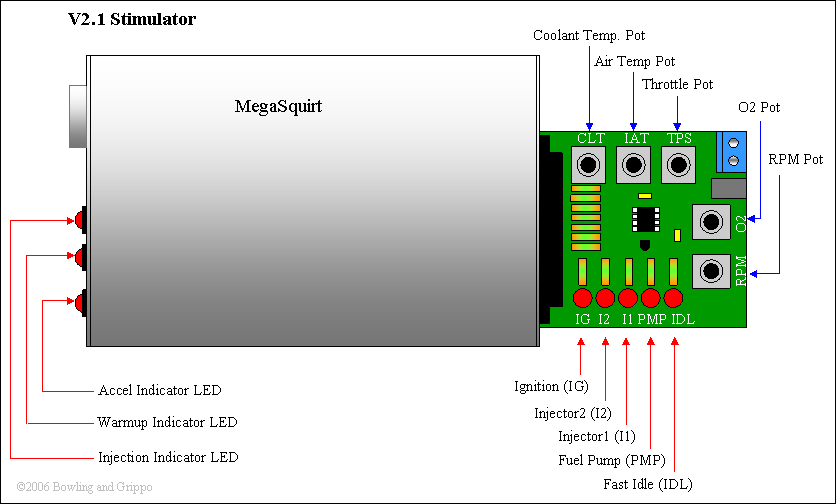
There are 5 LEDs on the Stimulator, and 3 on the MegaSquirt® controller. On the Stimulator, the 5 LEDs are:
On the MegaSquirt® EFI Controller, there are three LEDs, which are:
Note that these LEDs all do separate things.
The Injector LED on the MegaSquirt® controller lights when either Injector bank is commanded to fire, while the injector LEDs on the Stimulator light when each injector bank actually is grounded. The MegaSquirt® controller LED will flash synchronously with the Stimulator Injector LEDs in simultaneous mode, and will flash twice as fast as either LED in alternating mode.
The Warm-up Enrichment values are separate entries in the software from the Fast Idle Threshold value, so these two LEDs will generally light at different, though similar, coolant temperatures.
The Fuel Pump LED is light whenever the fuel pump relay is grounded. Since the Stimulator puts out about 1 pulse per second minimum, and the MegaSquirt® controller leaves the pump on for 2 seconds after the last ignition event, the fuel pump LED should be light whenever the Stimulator is plugged into the MegaSquirt® controller.
By using these LEDs, and adjusting the RPM, coolant and air temperature, EGO, and throttle potentiometers on the MegaStimulator, while viewing the TunerStudio tuning software, you ought to be able to test every function of your MegaSquirt® EFI Controller, except MAP function [for which you can suck and blow].
Note that the stim generally only allows you to turn the MegaSquirt® controller temperatures down to ~30°F or so (because of it's particular electrical design), and if you turn the pot all the other way around, you'll get 170°F. However this is the 'fault mode', which defaults to 170° when the sensor is shorted to ground. If you turn the pot back a bit, you should be able to get readings of at least 215°F in TunerStudio.